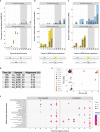Resistance to white spot syndrome virus in the European shore crab is associated with suppressed virion trafficking and heightened immune responses
- PMID: 36636327
- PMCID: PMC9831657
- DOI: 10.3389/fimmu.2022.1057421
Resistance to white spot syndrome virus in the European shore crab is associated with suppressed virion trafficking and heightened immune responses
Abstract
Introduction: All decapod crustaceans are considered potentially susceptible to White Spot Syndrome Virus (WSSV) infection, but the degree of White Spot Disease (WSD) susceptibility varies widely between species. The European shore crab Carcinus maenas can be infected with the virus for long periods of time without signs of disease. Given the high mortality rate of susceptible species, the differential susceptibility of these resistant hosts offers an opportunity to investigate mechanisms of disease resistance.
Methods: Here, the temporal transcriptional responses (mRNA and miRNA) of C. maenas following WSSV injection were analysed and compared to a previously published dataset for the highly WSSV susceptible Penaeus vannamei to identify key genes, processes and pathways contributing to increased WSD resistance.
Results: We show that, in contrast to P. vannamei, the transcriptional response during the first 2 days following WSSV injection in C. maenas is limited. During the later time points (7 days onwards), two groups of crabs were identified, a recalcitrant group where no replication of the virus occurred, and a group where significant viral replication occurred, with the transcriptional profiles of the latter group resembling those of WSSV-susceptible species. We identify key differences in the molecular responses of these groups to WSSV injection.
Discussion: We propose that increased WSD resistance in C. maenas may result from impaired WSSV endocytosis due to the inhibition of internal vesicle budding by dynamin-1, and a delay in movement to the nucleus caused by the downregulation of cytoskeletal transcripts required for WSSV cytoskeleton docking, during early stages of the infection. This response allows resistant hosts greater time to fine-tune immune responses associated with miRNA expression, apoptosis and the melanisation cascade to defend against, and clear, invading WSSV. These findings suggest that the initial stages of infection are key to resistance to WSSV in the crab and highlight possible pathways that could be targeted in farmed crustacean to enhance resistance to WSD.
Keywords: RNA-Seq; apoptosis; differential susceptibility; endocytosis; miRNAs; transcriptional response; white spot disease (WSD); whiteleg shrimp.
Copyright © 2022 Millard, Bickley, Bateman, Verbruggen, Farbos, Lange, Moore, Stentiford, Tyler, van Aerle and Santos.
Conflict of interest statement
The authors declare that the research was conducted in the absence of any commercial or financial relationships that could be construed as a potential conflict of interest.
Figures




Similar articles
-
Susceptibility to infection and pathogenicity of White Spot Disease (WSD) in non-model crustacean host taxa from temperate regions.J Invertebr Pathol. 2012 Jul;110(3):340-51. doi: 10.1016/j.jip.2012.03.022. Epub 2012 Mar 30. J Invertebr Pathol. 2012. PMID: 22484233
-
Proteomic analysis and white spot syndrome virus interaction of mud crab (Scylla olivacea) revealed responsive roles of the hemocytes.Fish Shellfish Immunol. 2019 Jun;89:458-467. doi: 10.1016/j.fsi.2019.03.070. Epub 2019 Apr 5. Fish Shellfish Immunol. 2019. PMID: 30954523
-
Susceptibility of juvenile European lobster Homarus gammarus to shrimp products infected with high and low doses of white spot syndrome virus.Dis Aquat Organ. 2012 Aug 27;100(2):169-84. doi: 10.3354/dao02474. Dis Aquat Organ. 2012. PMID: 23186704
-
Molecular Mechanisms of White Spot Syndrome Virus Infection and Perspectives on Treatments.Viruses. 2016 Jan 18;8(1):23. doi: 10.3390/v8010023. Viruses. 2016. PMID: 26797629 Free PMC article. Review.
-
Cellular responses in crustaceans under white spot syndrome virus infection.Fish Shellfish Immunol. 2023 Sep;140:108984. doi: 10.1016/j.fsi.2023.108984. Epub 2023 Aug 5. Fish Shellfish Immunol. 2023. PMID: 37549875 Review.
Cited by
-
Unveiling the multifaceted role of toll-like receptors in immunity of aquatic animals: pioneering strategies for disease management.Front Immunol. 2024 Oct 17;15:1378111. doi: 10.3389/fimmu.2024.1378111. eCollection 2024. Front Immunol. 2024. PMID: 39483482 Free PMC article. Review.
-
Experimental Infection Models and Their Usefulness for White Spot Syndrome Virus (WSSV) Research in Shrimp.Viruses. 2024 May 20;16(5):813. doi: 10.3390/v16050813. Viruses. 2024. PMID: 38793694 Free PMC article. Review.
References
-
- Corbel V, Zuprizal, Shi Z, Huang C, Sumartono, Arcier JM, et al. . Experimental infection of European crustaceans with white spot syndrome virus (WSSV). J Fish Dis (2001) 24:377–82. doi: 10.1046/j.1365-2761.2001.00302.x - DOI
-
- Rajendran KV, Vijayan KK, Santiago TC, Krol RM. Experimental host range and histopathology of white spot syndrome virus (WSSV) infection in shrimp, prawns, crabs and lobsters from India. J Fish Dis (1999) 22:183–91. doi: 10.1046/j.1365-2761.1999.00162.x - DOI
Publication types
MeSH terms
Substances
Grants and funding
LinkOut - more resources
Full Text Sources

